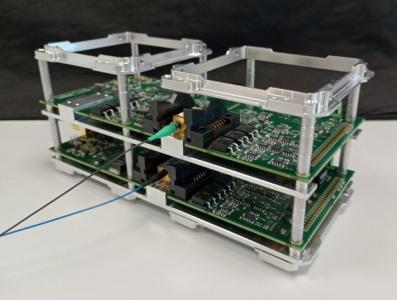High Stability Laser Control Module for Space Applications
Programme
GSTP
Programme Reference
G717-187MMb
Prime Contractor
RAL Space
Start Date
End Date
Status
Closed
Country
United Kingdom

Objectives
Background and justification:
•Most quantum technologies depend on stable and reliable laser light sources that are frequency-locked to an external reference such as an atomic/molecular spectroscopy line, a stabilised reference cavity or an external reference laser.
•For space applications there is a strong need to develop a robust set of electronics, suitable for the space environment, which can drive lasers directly whilst automatically finding and maintaining the required locking frequencies.
•Demonstrating these links from small satellites is desirable due to the fast development lifecycle of quantum sources and the potential for networks of quantum key generating satellites. However, the precision pointing required for the optical links is greater than current attitude control systems.
•An active alignment system, based on steering from a fine steering mirror, could be used to enable quantum communication links from small satellites.
Objective(s):
•This project aims to develop a Laser Control Module breadboard capable of providing a primary laser output locked to a defined Rubidium transition, and further laser outputs locked at a definable frequency offsets of up to 7 GHz.
•The electronics shall be designed with a clearly identified route to space applications.
Description
Achievements and status:
•The Laser Control Module breadboard has been completed and has successfully characterised in a laboratory environment.
•The laser drive subsystem has demonstrated a linewidth (1ms) of less than 75kHz, with sub-mK temperature stabilisation of the package. This design outcome has significantly assisted the HIROS instrument development on the ESA SCOUT CubeMAP programme.
•Automated Rubidium transition identification has been demonstrated, with robust locking performance demonstrated on Rb85 and Rb87 transitions. The signal-to-noise ratio of Modulation Transfer Spectroscopy signal has been enhanced to allow identification of further Rubidium transitions.
•Offset locking, at frequencies up to 8GHz from the primary laser, has been demonstrated.
Benefits:
•The Laser Control Module breadboard has demonstrated the viability of achieving a low-SWaP solution to ultra-stable laser sources with consideration for the constraints imposed on space component selection.
•The key enabling technologies, including low-noise laser drivers, have wide applicability in many fields.
•The demonstration of this performance in the optical and environmental conditions expected on a small satellite demonstrates the viability of quantum communication from small satellites.
Application Domain
Generic Technologies
Technology Domain
16 - Optics
Competence Domain
9-Digital Engineering
Keywords
Quantum
Initial TRL
TRL 2
Target TRL
TRL 4
Achieved TRL
TRL 4
Public Document
Final Presentation
Executive Summary
